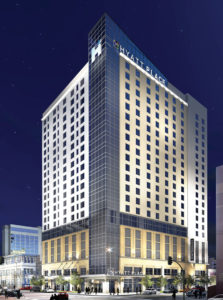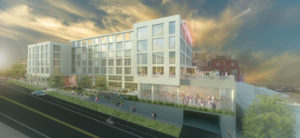DENVER—Following several years of occupancy growth, the hotel market in Denver has been leveling off while average rates continue to grow.
The Denver market has achieved marked growth in occupancy, average daily rate (ADR) and RevPAR, since 2010. According to STR, occupancy rose from 62.8% in 2010 to 75.6% in 2015. But for June YTD 2016, occupancy leveled off at 72.7%. ADR soared from $94.03 in 2010 to $120.86 in 2010. For June YTD 2016, ADR hit $123.78. RevPAR went up $59.08 in 2010 to $91.36 in 2015. For June YTD 2016, RevPAR reached $89.98.

The dual-branded Hyatt Place Denver/Downtown and Hyatt House Denver/Downtown opened Nov. 2015, marking the first combined Hyatt Place and Hyatt House hotels in the Denver area.
After several years of growth, HVS forecasts a peak in market occupancy between 2015 and 2016, followed by a slight decline to a more stabilized level near 75% by 2017. This stabilization point, almost 10 points higher than pre-recession levels, underscores the overall growth of hotel performance in the Denver metropolitan area since the end of the last recession, according to an HVS “In Focus” Lodging Report on Denver.
The entrance of several upscale full-service hotels in the market, combined with generally muted levels of new supply in suburban areas, has accelerated ADR growth since 2013. HVS forecasts more moderate rate growth through 2019, as operators of existing hotels adjust rates to help maintain occupancy and RevPAR in response to higher levels of new supply in 2016 and beyond.
Denver’s pipeline, as of the second quarter of 2016, consists of 63 projects or 9,290 rooms, adding to the city’s current supply of 315 projects and 44,893 rooms, according to Lodging Econometrics. There are currently 24 projects under construction, 28 projects starting in the next 12 months and 11 projects in early planning. Leading parent companies include Marriott International with 19 projects, Hilton Worldwide with 13 projects and InterContinental Hotels Group (IHG) with nine projects.
New hotel supply, scheduled to open through 2017, is largely concentrated in Downtown Denver with four planned hotels representing 686 rooms coming to the Lower Downtown (LoDo) area, according to HVS. These include the 200-room Westin Greenwood Village and a new boutique hotel from the Tribute Portfolio. The recent refurbishment of Denver Union Station, which is located a few blocks from the Colorado Convention Center as well as new dining and shopping areas, has fueled numerous hotel, apartment/condo and retail development in the area.
“The perception of Denver has changed over the years,” said Brett Russell, director of business, partner, HVS. “In the ‘70s and ‘80s, Denver was an oil and gas energy market. Since 2001, Denver has become a more diverse market with oil and gas now accounting for 10-15% of the market. Following 2007 and 2008, Denver weathered the recession across all boards compared to other places in the market. The diversification of the market has led to growth.”
For hotel developers, the Denver market offers an attractive investment as construction costs are relatively low compared to other cities in the U.S., such as those in California, combined with the consistent flow of lodging demand throughout the year, according to Catherine Bolstad, director, CBRE.
Factoring in existing supply breakdown, Scott F. Biethan, senior managing director, industry leader-hospitality and gaming group, CBRE Hotels, observed a broad distribution of various hotel chain scales for both upper-priced, full-service products and lower-priced, economy tiers throughout the Denver region. “There’s not a huge difference between the tiers,” he said. “Denver is one of those interesting markets.”

Tribute Portfolio, part of Starwood Hotels & Resorts Worldwide, has signed a new boutique hotel in Denver, slated to open Sept. 2018. The 165-room new-build will be situated in Lower Highlands (LoHi) on the west side of Downtown Denver
Key drivers fueling growth for business travel include Denver’s convention and business travel, including accessibility from Denver International Airport and the new Denver Airport Rail train, which brings travelers downtown; and a strong hotel presence with more than 9,000 rooms in downtown within various brands and price points, according to Rachel Benedick, VP of sales & services, Visit Denver. Additionally, Google is expanding its operation to a new four-acre campus in nearby Boulder.
Denver’s destination appeal is one of the top reasons for growth in leisure travel, observed Benedick. “The city’s downtown and many diverse neighborhoods offer chef-driven dining, a thriving arts scene and the top craft beer scene in the country,” she said. “Denver is also home to an array of events that draw visitors both regionally and from around the country, including exclusive cultural events like Yves Saint Laurent and Cartier exhibitions at the Denver Art Museum.”
Denver’s economy demonstrates no signs of slowing down as various areas in the city, especially Downtown Denver, undergo redevelopment. Denver’s Cherry Creek district and the River North (RiNo) area have seen an influx of new residential development. “We believe that Metro Denver and, more specifically, Downtown Denver, has become one of the most vibrant hotel markets in the U.S.,” said John A. Montgomery, managing director, Howath HTL. “Increases in demand have been seen in all sectors of Metropolitan Denver. However, the areas that have been the most dynamic are Downtown Denver, Cherry Creek and Denver International Airport markets.”
The brightest spot in the overall Metro Denver lodging market continues to be the downtown market area, which achieved one of the highest annual occupancies and the highest ADR of any of the market sectors in Metro Denver, according to Howath HTL’s May 2015 market report on Denver. Significant reasons for continued positive performance are the overall optimistic image of Downtown Denver. Howath HTL’s Montgomery concluded, “Denver has been going in a positive direction for the last five to six years, bringing the area out of the economic downturn from the 2008-2009 recession.” HB

